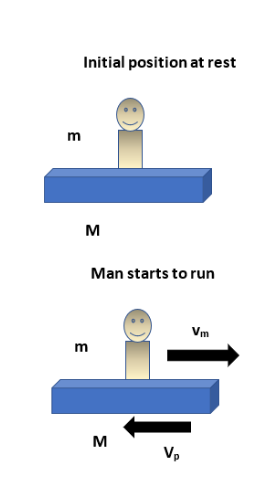
A man of mass m standing on a plank of mass M which is placed on a smooth horizontal surface, is initially at rest. The man suddenly starts running on the plank with a speed of
Answer
516.6k+ views
Hint: Conservation of linear momentum can be used to find the velocity of plank with respect to the ground. According to this initial momentum will be equal to the final momentum. In this case initial momentum will be zero since there is no motion at that time. So, we can equate zero to the final momentum. Therefore, we can find the speed of the plank.
Complete step by step answer:
This man-plank system is a linear momentum conserved system or centre of mass conserved system and there are no external forces since it is a smooth surface.
We can do it with the conservation of linear momentum concept.

According to the question m is the mass of man and M is the mass of plank. The man is running on the plank with a speed of
Velocity of the man with respect to the ground will be,
Now we can apply the conservation of momentum to the system.
According to this concept, initial momentum will be equal to final momentum.
Initially the momentum is zero, since there is no movement to the system.
Hence the final momentum will be equal to zero.
We can put equation (1) in equation (2) to get a simpler form.
So, the velocity of the plank with respect to the ground is given below.
Negative sign indicates the movement of the plank towards the opposite direction of the man.
Additional information:
Momentum is conserved in all types of collisions.
Both momentum and kinetic energy is conserved in elastic collision.
Momentum is conserved but kinetic energy is not conserved in non-perfect inelastic collisions. In this case the objects won’t stick together after the collision.
Momentum is conserved but kinetic energy is not conserved in inelastic collision. In this case the objects stick together after the collision. Therefore, their velocities will be the same.
Note: In the question we can see the smooth horizontal surface term. It means, there are no external forces like frictional force that will resist free motion. If you are doing conservation of the centre of mass, you should use displacement instead of velocity.
Complete step by step answer:
This man-plank system is a linear momentum conserved system or centre of mass conserved system and there are no external forces since it is a smooth surface.
We can do it with the conservation of linear momentum concept.

According to the question m is the mass of man and M is the mass of plank. The man is running on the plank with a speed of
Velocity of the man with respect to the ground will be,
Now we can apply the conservation of momentum to the system.
According to this concept, initial momentum will be equal to final momentum.
Initially the momentum is zero, since there is no movement to the system.
Hence the final momentum will be equal to zero.
We can put equation (1) in equation (2) to get a simpler form.
So, the velocity of the plank with respect to the ground is given below.
Negative sign indicates the movement of the plank towards the opposite direction of the man.
Additional information:
Momentum is conserved in all types of collisions.
Both momentum and kinetic energy is conserved in elastic collision.
Momentum is conserved but kinetic energy is not conserved in non-perfect inelastic collisions. In this case the objects won’t stick together after the collision.
Momentum is conserved but kinetic energy is not conserved in inelastic collision. In this case the objects stick together after the collision. Therefore, their velocities will be the same.
Note: In the question we can see the smooth horizontal surface term. It means, there are no external forces like frictional force that will resist free motion. If you are doing conservation of the centre of mass, you should use displacement instead of velocity.
Recently Updated Pages
Master Class 11 Business Studies: Engaging Questions & Answers for Success

Master Class 11 Accountancy: Engaging Questions & Answers for Success

Master Class 11 Computer Science: Engaging Questions & Answers for Success

Master Class 11 English: Engaging Questions & Answers for Success

Master Class 11 Social Science: Engaging Questions & Answers for Success

Master Class 11 Economics: Engaging Questions & Answers for Success

Trending doubts
Which one is a true fish A Jellyfish B Starfish C Dogfish class 11 biology CBSE

State and prove Bernoullis theorem class 11 physics CBSE

1 ton equals to A 100 kg B 1000 kg C 10 kg D 10000 class 11 physics CBSE

In which part of the body the blood is purified oxygenation class 11 biology CBSE

One Metric ton is equal to kg A 10000 B 1000 C 100 class 11 physics CBSE

Difference Between Prokaryotic Cells and Eukaryotic Cells




